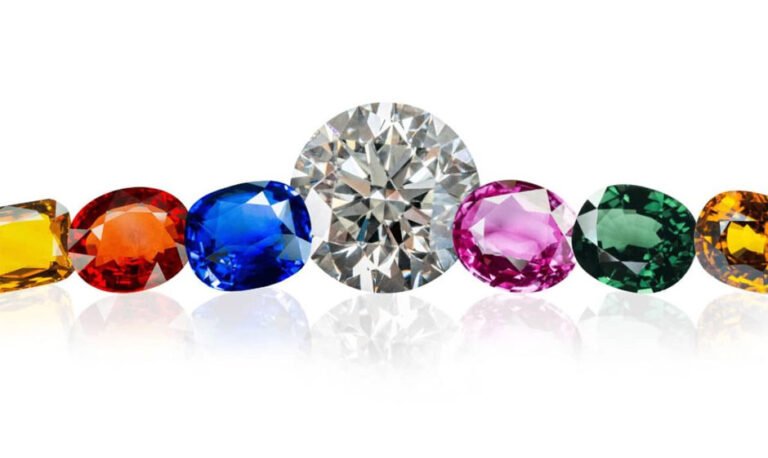Diamond pricing is notably influenced by their color, with some shades commanding higher prices in the market. Generally, diamonds that exhibit minimal or no apparent color are considered the most expensive. These are often termed “colorless” diamonds and are typically awarded the highest grades by the Gemological Institute of America (GIA). Conversely, diamonds with noticeable color variations are usually more budget-friendly, with their prices decreasing as their color intensity increases. Moreover, diamonds with unique and vibrant hues can fetch considerable value, making fancy-colored diamonds a prized and valuable category among enthusiasts and collectors.
Common facts to know before buying diamonds
Delving into the world of diamond purchases demands a foundational understanding. Diamonds, renowned gemstones, derive their value from key determinants. Familiarity with these essential facts empowers you to navigate the diamond market with confidence, facilitating informed choices when acquiring these enduring and precious gems.
1. The 4 Cs – Carat, Cut, Clarity, and Color:
Indeed, delving into the intricate world of diamonds necessitates a deep understanding of what experts call “The Four Cs.” Carat weight, the first among these, plays a role in the diamond’s size, but it’s imperative to recognize that size alone does not guarantee a diamond’s beauty. The cut, another crucial factor, holds the key to how a diamond interacts with light, directly impacting its brilliance and sparkle. Meanwhile, clarity unveils the presence of any internal or external imperfections, revealing the gem’s inner secrets. Lastly, the color grading measures the degree of color present within the stone, with less color being more highly prized.
2. Certification and grading:
Opt for diamonds certified by trusted authorities like GIA. These certificates provide a detailed analysis, ensuring your purchase meets expectations and simplifying comparisons. Certified diamonds offer transparency and informed choices.
3. Budget and prioritizing factors:
Establishing a budget is essential to avoid overspending. Determine what aspects of the diamond matter most to you. Size, quality, or a balanced combination of both? Understanding your preferences and budgetary limitations helps you select a diamond that not only reflects your desires but also represents a sound investment.
The value of diamonds based on their color
The worth of a diamond is intricately entwined with its color, a pivotal aspect in the evaluation of these precious gemstones. Color, a fundamental component of the Four Cs, significantly shapes a diamond’s market value and its aesthetic appeal. Here, we delve into this facet of diamond evaluation.
1. Color grading:
Diamonds are graded on a scale ranging from D (colorless) to Z (light yellow or brown) by reputable gemological laboratories such as the Gemological Institute of America (GIA). The closer a diamond is to the D end of the scale, the more valuable it becomes. Truly colorless diamonds allow light to pass through unobstructed, maximizing their brilliance.
2. Fancy-colored diamonds:
Beyond the spectrum of colorless diamonds lies a captivating world of fancy-colored diamonds. This segment includes diamonds exhibiting a plethora of hues, like vivid pinks, blues, and greens. Their value hinges on the rarity and intensity of their color. Rare Colors – Making Color Diamonds Attainable signifies the exceptional allure of vividly colored diamonds, often demanding a premium price in this unique category.
3. Setting and metal choice:
In the realm of diamonds, the choice of the setting and the metal can subtly impact the perceived color of the gem. White metals, such as platinum or white gold, can enhance the appearance of near-colorless or colorless diamonds, while yellow gold settings may complement diamonds with slightly warmer undertones.
How to choose the right shape of your diamond?
Selecting the right diamond shape is vital when designing jewelry to suit your style. It significantly influences the gem’s appearance and how it complements the wearer. Consider personal preferences, the wearer’s hand and finger attributes, and the overall jewelry design to make a confident choice. Your selection should enhance the diamond’s beauty and align with your desired style.
1. Personal preference:
When it comes to choosing the right diamond shape, your individual style and personal aesthetic should be the guiding light. Each diamond shape has its own unique visual charm, from the timeless sophistication of the round brilliant cut to the modern allure of the princess cut. Your preference should be the leading force steering your decision-making process.
2. Hand and finger shape:
Consider how the diamond shape will harmonize with the wearer’s hand and finger attributes. Certain shapes, such as marquise or oval, can create the illusion of longer fingers, while round or cushion shapes may better suit more delicate hands. Select a shape that enhances the wearer’s natural attributes.
3. Setting and jewelry design:
The broader jewelry design and setting play a pivotal role in your choice. Some shapes naturally complement specific settings and designs. For instance, a classic round or princess cut often shines in a solitaire setting, whereas intricate designs may find harmony in unconventional shapes like pear or heart. Your choice should align seamlessly with the jewelry’s overall design.



